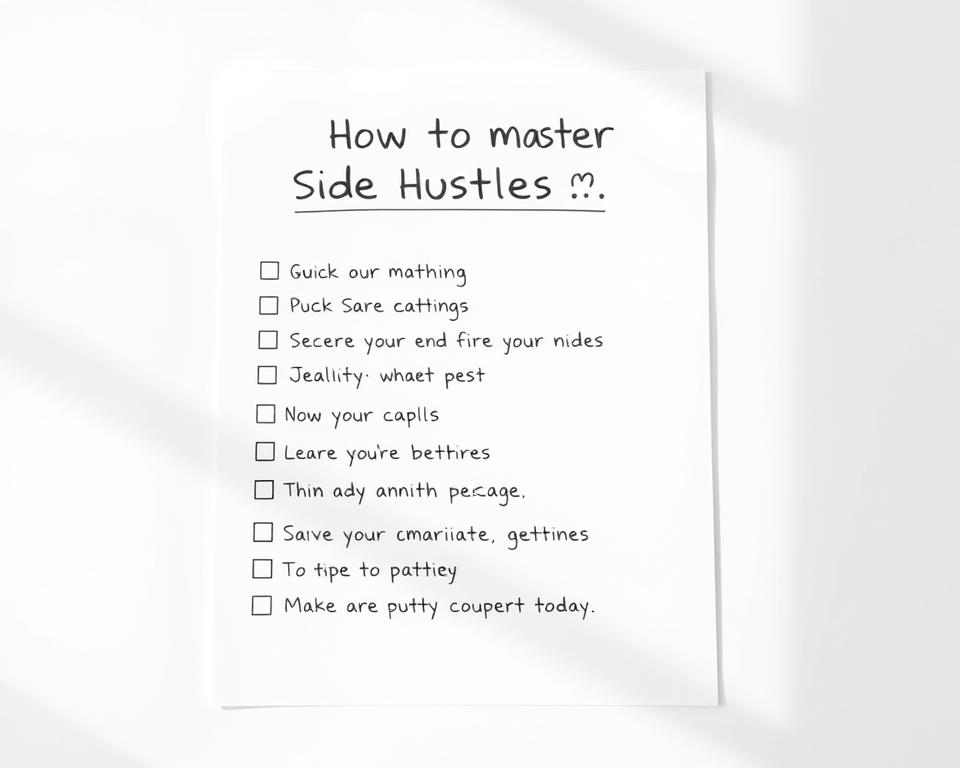Anúncios
Curious whether a smart side project could change your year? The first step is clear: learn how to Side Hustles with a practical checklist that fits real life and keeps your main job safe.
You’ll get simple ways to test ideas, pick platforms, and set a minimal tools stack so you can make steady progress even with limited time. A 2024 Bankrate survey found many Americans already run extra work, and platforms like YouTube, Substack, Amazon Flex, Instacart, and Rover show where beginners find traction.
We’ll start with your why, translate it into clear success metrics, and help you choose side hustle ideas that match your skills and local or online demand. Results vary by effort, market fit, and skill level, but you’ll leave with quick tests, simple pricing tips, and marketing steps that protect your time and income. Explore practical side hustle ideas and use this guide as a safe first map.
Define your “why” and success metrics before you start
Start by naming one clear goal and a few small measures you can check each week. Clarity helps you protect your main job while growing a side hustle without burning out.
- Extra money—steady small wins matter.
- Build specific skills for a future role or portfolio.
- Test an idea for a business before investing more.
Pick simple, trackable metrics
Choose one outcome metric and one effort metric. For example, aim for your first five customers or the first $100 and commit 3–5 hours per week on a fixed schedule.
- Outcome: subscribers, inquiries, booked sessions.
- Effort: posts per week, outreach emails, or hours of work logged.
- Market signals matter — inquiries and clicks show demand.
Track your effort and results weekly. If metrics stall after honest effort, adjust the offer, message, or channel. Share goals with a peer for accountability and keep notes on what works as you iterate.
Choose a right‑fit idea that matches skills, demand, and time
Find a compact project that uses what you already do well and fits into spare pockets of time.
Start by listing your top three skills. Match each skill to a low‑cost option like digital creation, tutoring, pet care, delivery, or reselling. This reduces ramp‑up and helps you see early wins.
Quick filters will speed decision making. Check for clear demand (search volume, active communities), low startup costs (use free tools first), simple platform access (fast approvals), and whether the work fits your energy that day.
- If you like being on camera, test YouTube or TikTok; if you prefer writing, try Substack or Medium.
- For hands‑on options, explore Rover or Wag for pet services and Amazon Flex or Instacart for delivery shifts.
- Validate reselling by listing a few items on Facebook Marketplace or vintage marketplaces and track views and messages.
- If ecommerce appeals but inventory is a barrier, research dropshipping and run a single product trial later.
Keep a short list of three hustle ideas. Test one at a time, use free tools for planning and tracking, and favor platforms with built‑in audiences to shorten the time to feedback.
Set up the minimum viable stack: tools, platforms, and workflows
Build a lean stack that covers publishing, payments, and simple task management so you can move quickly.
Start with a few lightweight pieces that handle scheduling, notes, invoicing, and basic customer tracking. Keep the stack small so you spend time creating, not fiddling with settings.
- Calendar for scheduling and a notes app for idea capture.
- Templates for outreach, proposals, and DMs so replies are fast.
- Simple CRM or a spreadsheet for leads and task management.
Starter platforms
- Pick one publishing platform first: Substack for newsletters, YouTube for long video, or TikTok/Instagram for short media.
- For selling, test print‑on‑demand (Printful + Shopify) to avoid inventory risks.
- For local gigs, sign up for Rover or Amazon Flex to reach customers and build ratings.
Use AI drafts for outlines, then edit for your voice. Set a weekly rhythm: planning, one content batch, outreach, and fulfillment. Track a few metrics — posts, inquiries, conversion, delivery time — and keep the stack lean until you need more advanced management.
Validate demand quickly with small tests
Run a few small tests that prove demand before you sink serious time or money into an idea. Short experiments give fast answers and keep risk low.
Micro‑launches are your best friend at this stage. Use one helpful video, a brief newsletter issue, or a pilot session to see if people respond.
Micro‑launch ideas: pilot sessions, sample content, preorders, and limited offers
- Publish sample content first—one YouTube/Shorts clip or a Substack issue—and watch views and clicks.
- Offer a 30‑minute pilot tutoring or consulting call at a reduced rate to learn real needs.
- Use preorders for digital products to measure real demand and cover final production costs.
- Run a limited offer for a small list and track replies, signups, or bookings as clear signals.
- Keep tests short (one to two weeks) and use simple tools like forms for signups and questions.
Ask for one action per test—subscribe, book, or preorder—so results are easy to read. Let metrics guide the next step: tweak the topic, title, or thumbnail if traction is weak.
Document what you learn, pivot fast, and repeat. These quick loops help you get started with a side hustle that fits your schedule and the market before you scale.
Content‑first online hustles for creators
A content-first approach lets you use one idea across many platforms and earn while you learn.
Monetize a YouTube channel
Publish useful videos: how-tos, reviews, and case studies build trust. YouTube reaches billions and pays via the Partner Program once you meet thresholds.
Start: post weekly for three months, track views and retention, then explore sponsorships and merch as you grow.
Start a blog or newsletter
Use Substack or Medium for subscriber revenue and simple writing workflows. Offer a paid tier, then add digital products or merch that match your topic.
Secure social media sponsorships
Pick one niche on TikTok or Instagram. Create short, useful clips and pitch brands once engagement is steady. Niche focus speeds deals and repeat work.
Record a podcast on a budget
Podcasting can be low cost: a sub‑$100 USB mic plus Audacity and batch recording saves time. Monetize later with ads or sponsors as listeners grow.
- Repurpose one long piece into clips, posts, and emails.
- Improve discoverability with clear titles, thumbnails, and basic marketing.
- Track retention, clicks, and replies and refine topics from those signals.
Profitable marketing and ecommerce hustles to explore
Consider low-risk marketing and ecommerce options that pair well with your existing content or skills.
Affiliate marketing and brand programs
Affiliate links can layer onto content you already publish. Start with products you use and be transparent with readers.
- Networks: Impact, Awin, and the Shopify Affiliate Program are common choices.
- Write helpful guides, reviews, or comparison posts that answer buyer questions first.
Sell digital products
Create templates, ebooks, mini‑courses, or media assets that solve one clear problem. Sell via a simple storefront or your newsletter.
Keep fulfillment instant and use clear delivery timelines so buyers know what they get.
Dropshipping and marketing services
Vet suppliers (DropCommerce, Syncee, AI Dropship), order samples, then run small ad tests before scaling. Focus on product page quality and basic ad creative.
Offer digital marketing services—social scheduling, SEO content, email, and ads—for small businesses that need results now. Use short case studies and platform portfolios to show outcomes.
- Start narrow: one product type or a single service package.
- Track unit economics: price, costs, and fees.
- Test channels one at a time: organic first, small paid experiments later.
Creative, design, and maker paths from home
You can launch creative products and services from home with low risk and fast feedback loops.
Start with a print‑on‑demand app like Printful. Upload artwork, pick mockups, and list items. The platform prints and ships, so you avoid inventory and upfront cost.
Develop a clothing line
Begin with curated dropship items to test style and fit. When a design sells steadily, move toward original prints or limited drops.
Sell photography and prints
Upload best shots to Shutterstock or Getty Images. Offer prints or local event gigs. Keep a simple portfolio and share sample content regularly.
Voiceover and virtual interior design
Record demos at home with a good mic, then list on Voices.com or freelance sites. For virtual design, build case‑style portfolios and a clear intake form.
- Show before/after photos or short reels to prove results.
- Package one‑room consults and fixed deliverables for easy buying.
- Collect client reviews fast and batch creative work for focus.
Flexible educator and communicator gigs
If you enjoy teaching, translating, or leading classes, these flexible gigs can fit around your main job and grow extra income.

Online tutoring and courses
Choose a tutoring niche you enjoy—STEM, test prep, languages, or business—and create a clear profile on platforms like Cambly, TutorOcean, Preply, or Learn to Be.
Offer a short intro session so learners see your style. Ask for reviews and add simple study guides or replay clips to your listings.
Transcription and translation
Start with Rev, TranscribeMe, or GoTranscript for transcription pay-per-file work. Practice with short audio clips to build speed and accuracy.
Translation work rewards verified samples and clear delivery windows. Treat each file as a mini project and track completion times.
Online fitness instruction
Host classes on Zoom or Instagram Live and sell simple subscriptions or class packs. Batch recordings and brief replays add value without extra live hours.
- Plan a weekly schedule you can keep—consistency builds students and subscribers.
- Track time, requests, and results; raise rates modestly when bookings fill.
- Keep communication clear, mind voice care, and update profiles with fresh reviews.
Hands‑on local hustles that fit a busy schedule
Local, hands‑on work can fit around a full job and still earn steady money.
Delivery and grocery blocks—Amazon Flex, Instacart, and Spark Driver let you book shifts that match your daily schedule. These gigs offer clear start/end times so you can plan around your main work.
Rideshare, airport rides, and room rentals
Rideshare apps like Uber and Lyft work for on‑demand driving. If you prefer predictable runs, consider Wingz for airport trips. Renting a spare room through major home‑sharing platforms can generate steady bookings. Use great photos and clear house rules for fewer surprises.
Neighborhood services you can offer
- Car detailing via TaskRabbit or Jobble for hourly work.
- Lawn care through TaskEasy or neighborhood listings.
- Local tours via Showaround or Airbnb Experiences.
- Pet care and walking on Rover, Wag, or PetBacker.
Track actual time per job, including travel and setup, so you know true hourly earnings. Start with friends and neighbors to gather early reviews and build local trust.
“Check platform rules and local regulations, and always prioritize safety when meeting strangers.”
how to Side Hustles: a beginner’s step‑by‑step checklist
Focus on one audience and one deliverable that solves a real need fast. This short checklist helps you get clear, publish a test, and learn from real feedback without overcommitting.
Plan
Define one offer, one audience, one primary channel, and two weekly time blocks you can keep. List the small tasks that must happen each week and the basic tools you need.
Prepare & Launch
Create one page or post that explains what you do, who benefits, and the outcome you deliver. Publish a sample on YouTube, Substack, or TikTok, then announce a limited pilot or preorder with a clear call‑to‑action.
Outreach, Deliver, Measure
- Send five personalized messages to potential clients or collaborators.
- Document delivery steps and keep tasks in a simple list so nothing slips.
- Track one effort metric and one result metric weekly to see cause and effect, and watch early money signals.
Iterate & Systemize
Adjust message, scope, or pricing based on feedback. Save templates for proposals, DMs, and follow‑ups in your tools. Review weekly: keep wins, stop what flops, and plan the next small test.
No guaranteed outcomes — just repeatable steps that help you get started and learn quickly.
Money basics: pricing, payment, and simple budgeting
Set straightforward pricing and tracking routines so earnings are easy to read.
Start with a simple pricing model. Pick hourly for open tasks, project rates for defined scope, retainers for repeat work, or value‑based fees when outcomes are clear.
Payments and tracking
Use an invoicing app and a separate bank account for side work. This keeps cash flow clean and helps basic cash management.
Set clear payment terms and due dates. That reduces back‑and‑forth and improves on‑time payment from each customer.
Simple monthly P&L
Track revenue and direct costs so you know net income each month. For products, include platform fees and refunds in your margin math.
- Price for time, tools, taxes, and a small support buffer.
- Add scope boundaries so unpaid extras are rare; upsell add‑ons instead.
- For subscriptions, list cadence and what customers receive on your website.
Review rates quarterly. As delivery gets faster, raise prices and keep a simple ledger that shows whether the effort earns real money.
Legal, tax, and platform policies to know
Good records and clear policies keep small projects from turning into big headaches.
Start with the basics. Pick a business name and check local license requirements. Rules vary by city and state, so a quick city website search saves time.
Business setup basics
Expect 1099 forms if you earn non‑employee income and set aside funds for taxes. Keep receipts, mileage logs, and a separate bank account so bookkeeping stays simple.
Disclosures and terms
Read platform policies before posting. Many platforms require clear affiliate disclosures and labeled sponsored media. Violations can limit reach or revenue.
- Add basic terms on your website: scope, timelines, and refund rules.
- Respect music, image, and font licenses to avoid takedowns.
- When in doubt, over‑communicate policies—transparency builds trust.
Consult a tax pro or attorney for specifics; laws and thresholds change by state and income.
Smart marketing for beginners without ad spend
Organic promotion wins when your posts solve real problems and point people toward one clear next step.
Magnet content: tutorials, reviews, and case studies
Lead with short tutorials, honest reviews, and mini case studies that show results. These pieces of content attract the right audience and act as a magnet.
Make one useful asset and turn it into clips, threads, and a simple offer. That steady output builds reach without paid campaigns.
Platform fit: YouTube for deep demos, TikTok for quick tips, Substack for deep dives
Match the message to the platform. YouTube fits longer demos, TikTok works for short tips, and Substack holds deeper notes and guides.
Post steady, answer comments, and repurpose the same idea across channels to save time and lift reach on social media.
Trust builders: testimonials, before/after, and social proof
Show quick before/after photos, one short testimonial, and mini case studies on your website or profile. Proof converts browsers into customers.
- Clear CTA: subscribe, book, or download.
- Repurpose one core piece into multiple posts.
- Collaborate with peers for cross promotion.
Consistency beats volume for beginners — publish steady and watch what sticks.
Time management and burnout prevention
A steady, simple rhythm beats sporadic effort — set compact sessions that fit your calendar and stick to them.
Good routine protects your energy and keeps progress steady. Use short blocks that match your peak focus and protect a recovery day each week.
Timeboxing, batching, and one‑hour sprint workflows
Timebox two short blocks per week for the project; tiny, consistent windows beat marathon sessions.
Batch similar tasks — research, scripting, recording, editing — so you avoid constant context switching.
Try one‑hour sprints for quick wins: draft a post, send an outreach batch, or update a landing page.
Automate low‑value tasks and protect recovery
Automate routine admin with schedulers and templates so you spend more energy on delivery and sales.
Declutter your stack: fewer tools mean less friction and a cleaner work experience.
- Keep a simple weekly plan you can finish even on busy weeks; hold one backup slot.
- Track focus hours and align creative work with your peak energy.
- Review workload monthly and prune commitments that don’t move your goals.
Notice stress signals early; pause or simplify instead of quitting altogether.
Practical note: use free tools like Audacity for editing and platform schedulers for posting. That lowers admin and helps sustain a small side hustle without burning out.
Scale what works: systems, upsells, and diversification
Scale by standardizing what works: small systems let you serve more clients without burning out.
Start with documentation. Write concise SOPs for your best-performing steps and save templates for proposals, emails, and deliverables. This speeds work and keeps quality steady.
Next, turn custom gigs into repeatable packages. Clear scope and fixed pricing make onboarding faster and reduce back-and-forth with customers.
Expand revenue ethically
Add affiliate programs that match your audience and disclose them plainly. Pitch small sponsorships once engagement is steady; offer defined deliverables and short trials.
- Convert services into products—toolkits, mini‑courses, or templates—to boost income without more hours.
- Test dropshipping with one curated product that complements your niche before scaling inventory risk.
- Use a warm referral system: a simple referral page and a thank‑you reward brings steady client leads.
Grow carefully: add one marketing channel at a time and subcontract documented steps when demand exceeds your capacity. Reinvest in evergreen content and better onboarding so your business compounds over time.
Standardization first, expansion second—this keeps quality, trust, and profit aligned.
Conclusion
Close this guide by focusing on steady signals—replies, bookings, and repeat customers—that show real demand. Use the checklist to pick one idea and run a short test. Measure results, then iterate based on clear feedback.
Your path will be unique. Outcomes depend on your skills, effort, market fit, and the time you can commit. Platforms like YouTube, Substack, Amazon Flex, Instacart, and Rover make testing easier for many people.
Protect your energy and schedule so a side hustle supports your life, not the other way around. If you need tailored help, consider a mentor, a small‑business advisor, or a tax pro. Stay patient: steady work and small wins compound into real income and better money choices.



